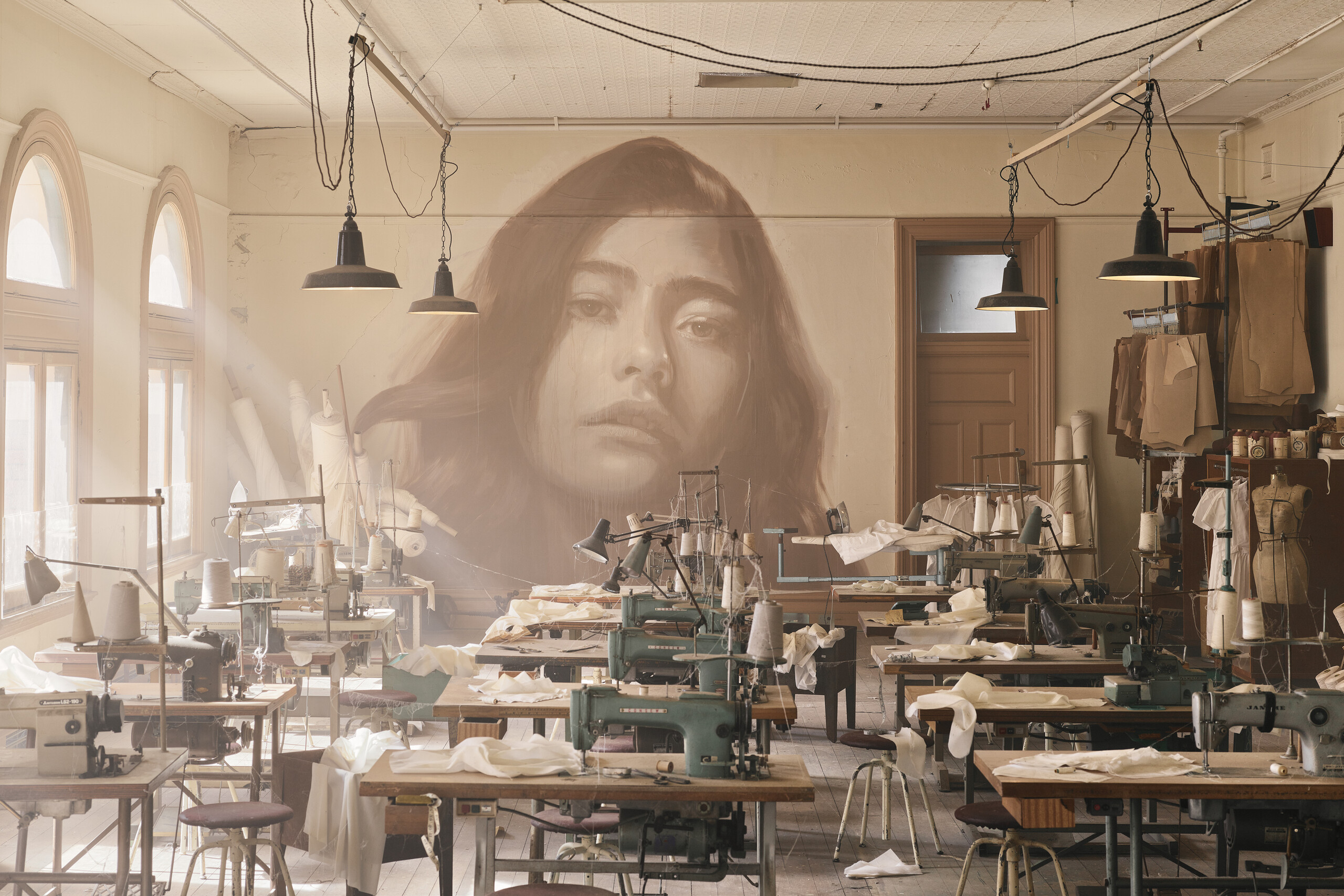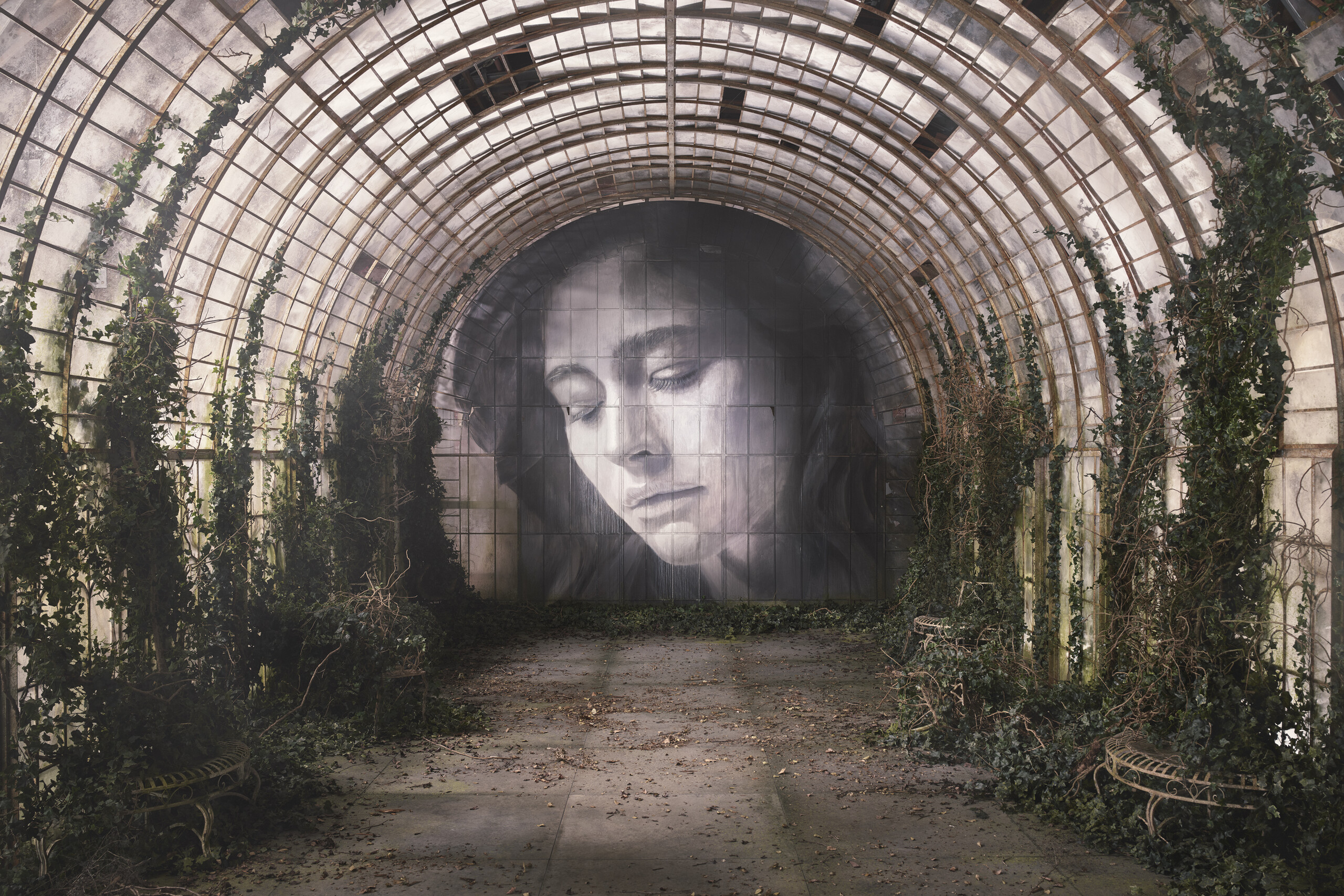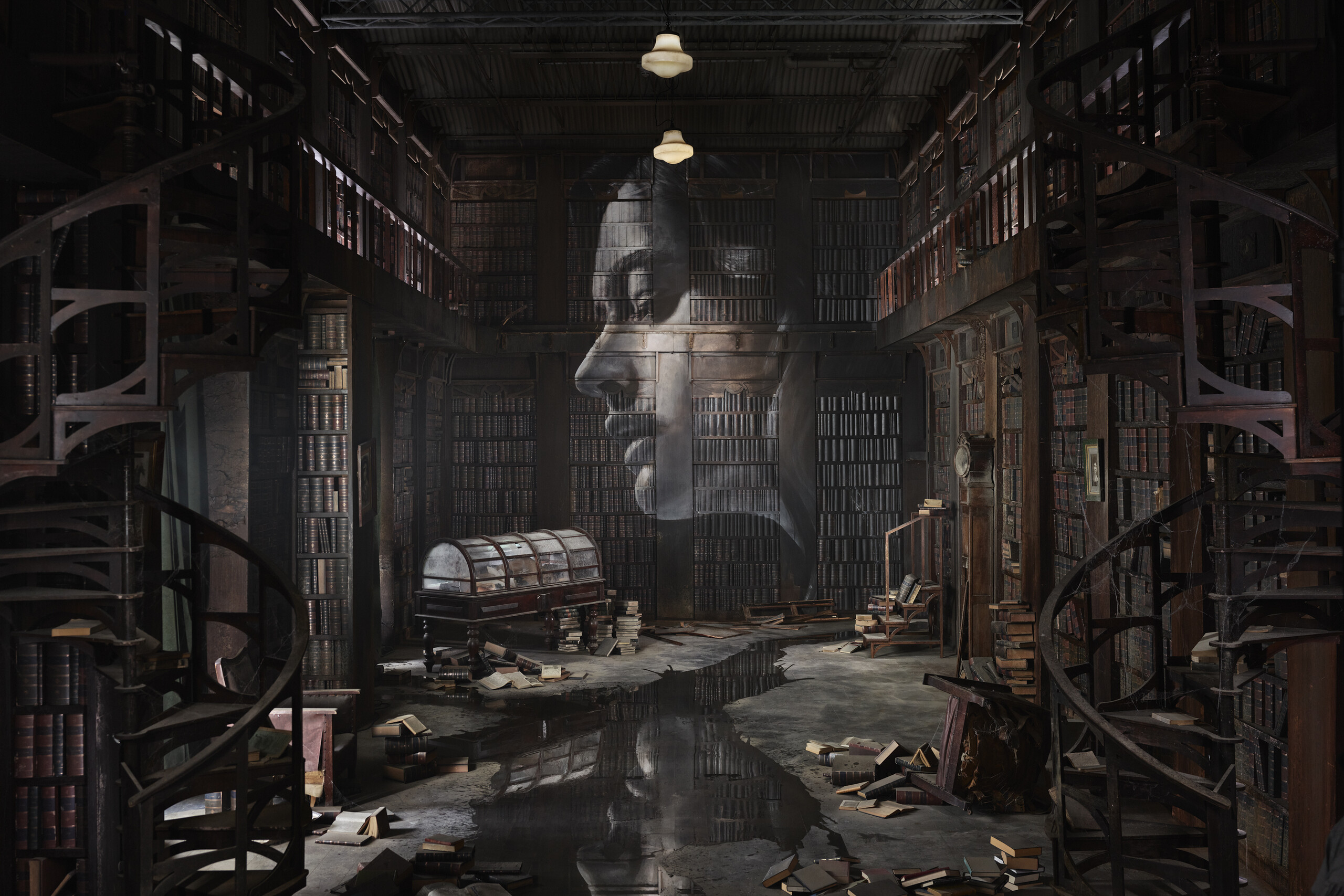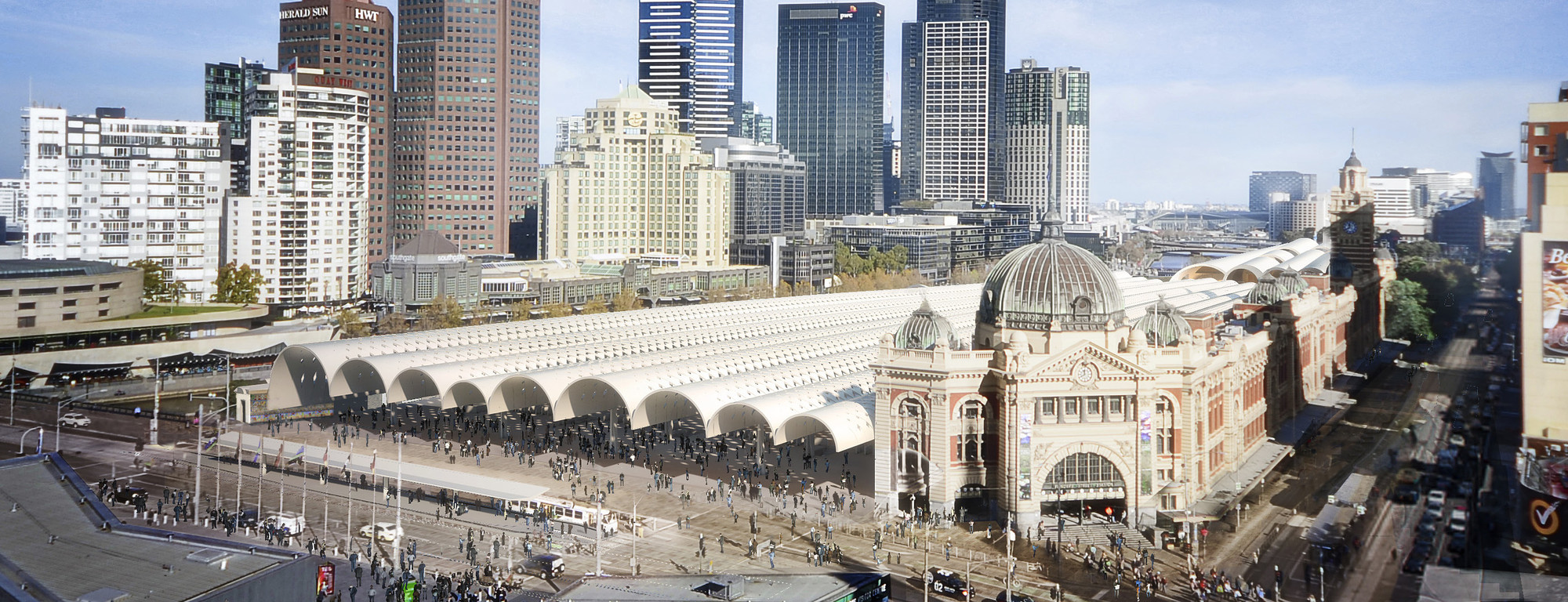TIME·RONE
Giles Fielke
Over the summer break many tenants of the Nicholas Building, mostly long-term studio artists, have been forced into the difficult decision to vacate, as the Swanston Street building is made more “marketable” for sale. Rents increase (it’s what they do). But this dramatic driving up of the cost of working space in the city’s best-known creative hub has already smashed the delicate conditions that have seen the nine-floor building flourish as a real community for a variety of artists, gallerists—most committed to showing non-commercial work—and small businesses over the previous decades. As if it wasn’t already clear: Melbourne, Australia, has entered its real-estate era. The reality is, of course, that it has been this way since 1835.
With this in the back of my mind, I get the official direction to enter Time “via door at 273 Flinders St, near Boost Juice,” and realise the instruction says far more about the experience of the exhibition by Rone than at first glance. What first struck me as odd, or slightly comical, as I arrived at the anonymous street-level entranceway now seems key for understanding the immersive installation in the centre of the CBD: it is the built environment as a fully integrated retail space. When I visit just before Christmas, I walk past hundreds of people of waiting in line to file past the Myer Windows. (We can do that later.)

Employees of Rone International Pty Ltd are located at the entrance to the upper reaches of the famous Flinders Street Station building and exude this retail-festival mood in their tired yet happy expressions. To take the lift up to Rone’s latest offsite project is to participate in what has so far been an undeniably huge commercial success for the maverick street artist. But what does this enterprising work have to say about the state of art in Melbourne as we emerge from the extraordinary and disrupted period of COVID-19 lockdowns? What truths can be gleaned from the not-so-vacant eyes of Rone’s so-called Jane Doe, the painted woman whose face appears repeated in nearly every room of the exhibition?
It would be too “elitist” of me, perhaps, to dismiss Time as both a sublime and demented array of kitsch from mid-century Melbourne, reconstructed from documentation of the era or more likely salvaged from small-town op shops and vintage bazaars, where you might still find stacks of dress patterns or old issues of Fishing Magazine on sale at the bargain price of one dollar for five issues. On his Instagram account Rone answers many commenters below his posts in earnest: “about 3 years, 18 months build, 4 months assembly” reads one of his many replies to inquisitive fans inquiring about the massive undertaking. When I am there, some visitors appear moved to tears by the displays. Alternatively, you might imagine a Rone International employee tasked with trawling Ebay store listings for magazines by publication year bracket 1940 to 1979.
Following its installation, ably produced with the assistance of Belinda Collins’s Social Crew creative studio, everything in the exhibit has been covered in dust and cobwebs to make sure it looks like a seventy-something year-old moment frozen in time. Above the city centre, whilst everything else changed around it, Flinders Street Station has become a monument to the past glory of colonial-era Melbourne. “Can’t believe this space was just sitting there unused!” Comments like this, addressing other viewers curious to explore the public building, fill Rone’s socials. Tying it all together are two key strands that link the exhibition spaces conceptually, like the one-hundred-metre-long corridor that looks out over the platforms below (despite most of the windows remaining covered or blacked out).
The first strand is the soundtrack by Nick Batterham, who has worked with Rone on three projects since 2019’s Empire. Piped throughout the floor and timed to crescendo with the lighting designs for each room, this music can be compared to the Game of Thrones OST or filed easily within the colonial ballads section at your local record store. So successful has this genre become that it is difficult to distinguish from the soundtracks to nearly all recent Australian-related cultural productions: from Nick Cave and Warren Ellis’s soundtrack for Andrew Dominik’s Blonde, to their score for Dahmer – Monster: The Jeffrey Dahmer Story. It fits on the same continuum that goes back to Kylie Minogue and Cave’s Murder Ballads collaboration, Where the Wild Roses Grow, from 1995 (and in fact oftentimes feels interchangeable). All of Batterham’s soundtracks are available on Spotify (where you could also compare them with the more palatable evolution of this sound, for example Oliver Coates’s recent score for Thomas M. Wright’s film The Stranger). The schmaltzy, minor chord waltzes and compositions for strings and brass deliberately aim to manipulate and augment visitors’ emotional responses, which are set to swell in time to the precisely timed musical crescendos.
Then there is the woman. Jane Doe, a David Bromley-esque archetype of the white settler-colonist beauty who stares blankly at the resurrected “Work Room” and is glimpsed in silhouette in “The Library.” Resilient and staunch, inviting yet indifferent to your attentions, whatever they may be, the face Rone has made the centrepiece of every immersive installation he has created deserves careful consideration here. A femme fatale yet equally drawing on the Lost Child archetype, her muralised presence operates as the model viewer: passive, looking but also engaged, on display—public.

In a recently revisited anecdote by Marshall McLuhan, shared and commented on Twitter by millions of users, the Canadian media-theorist neatly describes (during a TV segment in 1977 titled “Violence as a quest for identity”) the way nostalgia functions in a growing surveillance state and how our anxiety over identity operates as its corollary in what was then termed the “electric age”:
We now have the means to keep everyone under surveillance…Just watching other people and keeping a record of their goings on…Everybody has become porous…When you don’t have a physical body, you are a discarnate being. You have a very different relation to the world around you. Everybody tends to merge his identity with other people at the speed of light… One of the big marks of the loss of identity is nostalgia… The revival tells us who we are or were.
Rone’s discarnate being is the face of Teresa, who is also a close friend of the artist (as the invigilator I have bailed-up dutifully explains). Similar in effect to the public, large-scale portraiture projects undertaken by French artist JR, Rone’s insistence on classic, realist beauty is both catholic and Catholic. I can’t help but immediately connect the woman with St Teresa of Avila and possibly the most famous of the Baroque sculptures completed in white marble by Gian Lorenzo Bernini in Rome during the seventeenth century. While Teresa had sought martyrdom against Islam as a fanatical seven-year-old at the same time as the Magellan expedition, our present Teresa offers a weakened, yet persistent echo, demonstrating the power of religious devotion and colonial imposition exactly five centuries hence. Everyone visiting the exhibition is white, including me and I’ve arrived with three generations of my family.
As the statement for the tableau of Without Darkness There Is No Light (a free shipping container installation of Rone’s work made for the Geelong Gallery and currently on display on the forecourt of the Melbourne Arts Centre) explains, “the nature of the works disappearing, or being up visible for a fleeting time, is a centre of Rone’s work.” It is this notion of a transitory production model that requires a staging of the work, an immersive installation, which borrows from the logic of the film production set. Yet, as most blockbusters do, it is built on clichés carved out for a clearly demarcated audience. Once this has been established, as an investment in an industry that pairs a production with a targeted and widely identified market viability, its popularity makes far more sense.
After opening in late October 2022, Time is currently “sold out” through February. At $39.70 for general admission ($34.70 concession), the spectacle is double the cost of a ticket to an A-League match at AAMI park and even more than entry to the annual Winter Masterpieces exhibit at the NGV (The Picasso Century cost $30 for adult admission). With the expectation of 25,000 visitors each month, TIME·RONE (even the title of the exhibition is an awkward punning on the artist’s first name, Tyrone) is probably earning more in ticket receipts over its lifespan of six months than AAMI park is from the current A-League season.
When doing the maths, the numbers become more and more staggering: open for fifty-seven hours each week, online ticket sales are capped at one-hundred visitors per hour. That means that upwards of five-thousand visitors have filed through every week since it opened. Time is open for twenty weeks. Forgetting the merchandise (I’ll get to that), ticket sales sold at the current rates of capacity will generate nearly six million dollars. The obvious question is: does it mean that from the $1.8 million federal grant Rone International Pty Ltd received from the Federal Government in 2020. Time has added six million dollars to its coffers by the end of April? How is it, then, that this public investment has been granted to such a profitable business, and in the guise of an arts grant? Should state arts funding—even if motivated by the COVID-19 crisis—and even “art” as such be used in this way, that is, following a private model for the art market? Should art be used to generate profits for state governments to collect? Remember the site is a formerly vacant public building, now collecting a large amount of rent no doubt. This is the complex problem that Time puts on display: the typing pool and administration of public works, electric communication and even socialisation are central to the installations. Perhaps these eye-watering proceeds could be used to fund less profitable art forms or more challenging projects (remember the Nicholas Building, anyone?).
Not quite within the Melbourne Arts Precinct (but potentially a satellite exhibition space for this gateway to the city), the third floor of Flinders Street Station is just one part of the larger VicTrack asset. Once the home of the Victorian Railway Institute (VRI), at different times during the station’s history—as the breathless press release for Time explains—these rooms have housed “a gymnasium, billiard room, a lending library and sewing room. The rooms later housed offices. This part of the building has been empty since the 1980s.” It is this history that essentially provides the logical basis for Rone’s intervention, where the artist has arranged for everything to be painstakingly and meticulously reconstructed, re-imagining this apparent emptiness as a commercial opportunity. (As an aside, and despite the privatisation of the Victorian railways by the Kennett Government in 1999, the VRI remains in operation today, with member benefits offering a range of opportunities, as well as access to holiday properties owned and managed by the institute in Jan Juc and on the Gold Coast in QLD). The restoration of these spaces has been given a lot of attention in recent years, following the Builders Labourers Federation placing a Green Ban on the redevelopment of the site in 1975, effectively licensing the heritage status of the station.

In a certain sense the success of Time is due to the emphasis placed on the legitimacy of popular spectacle by the National Gallery of Victoria. That they now have to compete with other statutory bodies for art events is ironic. The Social Crew list the NGV as a regular client. In the nineteenth century the avant-gardes left the state academies to pursue art as a private business—we know how successful that model has been. Is it now simply the case that the state has grown jealous of this model? After all, Rone’s education was as a street artist, pursued by the law for illegal painting projects and skating. His Everfresh Studio boasts its “mindless vandalism” as a business model on its frontpage. This is, quite literally, the apotheosis of Melbourne’s famed street art culture, the one best captured in Eddie Martin’s documentary subject Jisoe, from 2005, where the miscreant becomes king.
It is not an understatement to claim that over the past decade Rone has steadily become one of the most popular artists in the country. Born in Geelong in the year Bob Hawke was first elected to parliament as the member for Wills, Tyrone Wright’s work as a graffiti artist under the Rone moniker has embodied a Gen-X fervour for anti-authoritarianism and entrepreneurial spirit that has now entered an era of institutional power (I have always found it hard to believe that Scott Morrison is younger than Kurt Cobain). Rone belongs to, at least according to his own website, “one prolific group of artists (that) has continually turned Melbourne’s streets into their canvases. The group is known as Everfresh, and its work is a fusion of explosive colour, intricate line work, iconic characters and visual stories that can be appreciated (or condemned) not only in the streets and laneways of their native Melbourne, but in public spaces around the world.”
Operating out of a former industrial building just behind the Friends of the Earth Coop on Smith Street in Collingwood, Rone, Reka, Sync and Wonderlust are now nearly two decades into their careers, and the Everfresh Studio artists have steadily developed international acclaim through their hard work and grindset, no doubt. In ways that appear similar to the lucrative urban appeal of street artists entering the commercial art industry, like Kaws (similarly stylised KAWS), the Everfresh crew are working artists—not navel-gazers—and so their promise is client-focussed, neither cerebral nor academic. Their effects are immediate. Yet as Rone transitions to the mainstream and even elite levels of success, a bout of self-reflection seems imminent.

In interviews, Rone claims to have begun his professional career as a full-time artist in 2011, which he endearingly exclaims as his dream job. To further justify his recent success, he adoringly claims to get up every morning at 7am. It is also significant that in 2016 Rone first created an immersive art installation in a derelict movie theatre, the site of the Star Lyric Theatre that developer SMA was controversially turning into an Aldi and multi-story apartment complex on Johnston Street, Fitzroy. From this collaboration with property development Rone landed upon the formula we see in Time: twentieth-century nostalgia focussed upon forms of life passing out of living memory and waiting to be memorialised, if only fleetingly as a paste-up or sprayed façade awaiting demolition, renovation and gentrification. It is in this sense that Rone’s work as a graffti-artist/painter is better understood as monumental sculpture, or installation art gone wild, that is, in its iconographic melange of modern art tropes it is available to be seamlessly blended with the time-based performances of spectacle culture and capital works. Nothing is permanent, and with nothing lasting forever, beauty is understood as nostalgia for a thing you could never possess.
The question of what would be done with the recently restored spaces of Flinders Street Station was first answered when Patricia Piccinini’s A Miracle Constantly Repeated, was staged in the station’s ballroom as a part of the 2021 Rising Festival (only open for one day before a new set of COVID-19 restrictions meant the space was closed again to the public). Earlier, at the end of 2020, Rone was awarded a grant as a part of the two-hundred million dollar Restart Investment to Sustain and Expand (RISE) grants program overseen by former federal government Minister for Communications, Urban Infrastructure, Cities and the Arts, Paul Fletcher. The $1.86 million investment meant Rone’s eponymous business (est. 2016) could become the employer of the dozens of people working at Time for the duration of the exhibition, and presumably includes the plan for leasing the VicTrack building for its use for more than six months (although when asked VicTrack claimed to have no relationship with Rone). The circuitous nature of the funding model used to stage Time is really mind-bending here, as council, state, and federal assets all seem to have been deployed for its production, which essentially remains a private enterprise (at least as far as I can tell).
The grant announcement couldn’t be clearer:
Rone International will present audiences with a journey through a mystery story in a deserted space, signature murals surrounded by the furnishings and fixtures suspended in time, a musical soundtrack leaving audiences feeling as though they are immersed within a movie rather than an exhibition.
The original design of the now deserted space, which first opened in 1910, was a once-off collaboration by architect J.W. Fawcett and civil engineer H.P.C. Ashworth (who died in 1903 at age thirty-two, and who therefore didn’t get to see the project to completion). In 2013 the Swiss architecture firm Herzog & de Meuron, in collaboration with the Australian design firm HASSELL, won a competition to re-design the celebrated station building, which had first opened in 1910. Yet while the re-design—which looks like a giant has dropped a packet of cigarettes along the Birrarung—hasn’t been announced as a funded project just yet, $100 million of urgent restoration works was undertaken on the building over the past decade, mainly seeking to make it safe and able to be re-opened to the public—seemingly for art projects.

What I am saying to you, our cherished Memo readers, is obvious: do not go and see Time. If you really want to, you can envision the crowds through the satellite or pop-up store at Shop 30 Flinders Street, part of the Shopfront Activation Program operated by the City of Melbourne. This retail marketing model targets “artists, budding entrepreneurs and artisan makers to occupy space to test their business ideas and help attract Melburnians back into the city”. Titled The Newsagency, here you may get a taste of the full immersive space, and at street level day-trippers can browse the wares on sale without planning ahead. From AU$7 greeting cards through to AU$300 Open Edition Prints of scenes from Time—jigsaw puzzles, papercraft models, even a silk scarf depicting The Glasshouse (AU$149.95)—everything is for sale.

Where Banksy’s Exit Via the Gift Shop deployed a knowing irony at his complicit engagement with the culture industry, Rone’s gift shop is less a gallery exit, and more the destination of city culture. This earnest, unironic embrace of culture as commodity does feel tragic (even to the artist, I am sure), yet its nostalgia for an imagined past is presented as the only thing that might feel real for us today. This is modernism stripped of its utopian radicality; another world is not possible.
If questions remain: Is it art? Yes. Is it good art? No. Does that matter? Certainly not. Why? Because it is a wildly successful investment by the federal government in visual culture, cities, and infrastructure projects: it does what it says on the packet. But what does it say about the state of the arts when the state chooses “mindless vandalism”? This gets to the core of what is revealed by Time: the power of nostalgia. It is why Make America Great Again worked. It is dangerous. This is nostalgia for an imagined past—one that has been smoothed and made idealised in the minds of those who now have access to locations such as the central stations and other of our most famous institutions. Nevertheless, it reveals a truth: Australia as the site of mindless vandalism by corporate colonial interests. This is how these figures collaborate to re-shape a national identity. It is what we deserve, art imitates life.
Giles Fielke is an editor of Memo Review.


